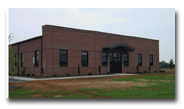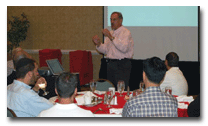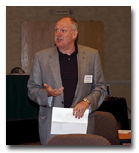I
ndustry veteran John Bakane started with Greensboro, N.C.-based Cone Denim in 1975. Cone,
which has been in business for 115 years, prides itself on being the largest denim manufacturer in
the world and supplier to many major brands.
 John Bakane, president and CEO of Cone Denim
John Bakane, president and CEO of Cone Denim
“If you look at us today, as we have become part of Wilbur Ross’ International Textile Group
[ITG], we have operations not only in this hemisphere, in terms of the US and throughout Latin
America, but also a joint venture in Turkey; and we are in the early stages of building an
operation in China. We are well represented throughout those markets,” Bakane said. “With Wilbur
Ross’ backing, we have put together projects on the order of a quarter of a billion dollars of
investment over the next year or so.”
TW: Cone has a track record of investing globally. What is the process for
determining where those investments are made?
Bakane: The first thing is to always look to our customers in terms of where they
are headed. We say we are “the tail on the dog.” We provide the fabric; others provide the cut and
sew; others, the laundries and denim finishes; and others put brands on it and take it to retail.
So we look to our customers first for where they are planning investment for the future.
Secondly, we look to our product itself, the inputs and the availability. For instance, for
our business there is a high priority on where cotton is grown. We see three regions of the world
controlling 75 percent of the cotton that is grown around the world. The Americas, with the US
producing about 22 million bales of cotton a year and due to strong agricultural incentive
programs, we feel it is important to be in this region because of the availability of raw material.
A second place is China. China is the largest grower of cotton in the world, with about 27 to 28
million bales per year, so they are definitely going to be big in the denim business. A third
region is the Indian sub-continent, which between Pakistan and India grows about 22 million bales
of cotton per year — and that is the third leg of our investment strategy.
Then we look at human resources. We start to look at infrastructure — roads, availability of
good electrical power; and then we start to look at the economies of the region — how they are
expected to react in terms of foreign currency exchange and competitiveness in the long term.
TW: Many US-based companies have a significant North American investment in plants
and equipment, infrastructure and skilled employees. As capacity utilization fell, the idea of
moving versus using existing capacity seemed a little crazy, if goods could be efficiently moved
into the Central American region. Might this be one of the reasons there wasn’t more yarn and
fabric investment in the region?
Bakane: The bottomline decision criteria for making those kinds of investments is
the horizon you choose for the business. At Cone, we have for a long time been a long-term horizon
investor. If you go back to our founder in 1891, [they] moved from Germany and believed in making
investments for the long term. They believed in investing in communities and people who would be
there for the long term.
Going back to the early 1990s, there really was a bifurcation of the US textile industry.
Part of the industry said, “No, we are going to stay here in the States and fight it out. We think
we can do that with legislation, with cutting costs and by being as efficient and effective as
possible.”
There was another group that consisted of companies like Cone that said, “You know, in the
long term, industries move. If you look in the United States, the textile and apparel industry
started out in the Northeast, in places like Fall River, Mass., and migrated southward. It is
inevitable.” So, we are going to continue to see a migration to lower-cost countries for the
textile and apparel business, and what we need to do is to make investment in terms of
infrastructure — people, philosophies and capital. So we have had that philosophy since the early ‘
90s. We were the first US denim company to invest in Mexico, the first in Turkey, the first in
India — and we will be the first in China. We are in this business to stay; we are in this business
for the long term.
One of the issues is you can get into a situation of being in a self-fulfilling prophecy. If
you choose to stay in the States and defend what you have, you cut your costs — which means you
skimp on people development, you skimp on equipment development, and you circle the wagons. If you
have chosen philosophically to invest in the long term, you’ve always tried to have capital sources
to make that investment, but more importantly, you’ve invested in people — the development of those
people — so you can send a team to Mexico or Central America or India or China or Turkey to produce
first-quality product.
TW: Let’s talk about Nicaragua. Bringing 28 million yards and 750 jobs to the
country while spending $100 million sounds like a pretty interesting commitment.
Bakane: Yes. When I look at it, I can stay up all night because it is around a
$100 million commitment. It means 750 jobs within our plant walls, but probably when you look at
indirect, apparel and infrastructure employment, this project will generate around 20,000 jobs
altogether. It is a major project, and the one thing that keeps Matt Haynes, our project manager
here, and me up at night is that this is probably the biggest single project — the biggest building
in terms of square footage — we are talking about 630,000 square feet — that has ever been built in
Nicaragua, and probably one of the biggest ever built in Central America. So we are making a big
bet in terms of Nicaragua.
I am very excited about Cone Denim overall. One of the reasons is that by doing business
around the world, whether it’s the US, Mexico, Turkey, Nicaragua or China, we are not hostage to
any one market or government. Contrary to popular belief, China and India are not the be-all for
textiles. There is always going to be a place for China in the cotton textile business. But we have
a saying,”Trees don’t grow to the sky,” and China will not have every ounce of business in the
world. There are issues in terms of cotton. China grew 28 million bales or so, but they used 45
million bales of cotton, so there are some natural limitations in terms of growth there. If you
listen to all the talk of realignment of currencies, you are going to see at some point the Chinese
renminbi being much more expensive, and the cost to produce is going up there.
India is very encouraging, and at some point, on the Indian subcontinent — be it Pakistan,
India or Bangladesh — we will have an operation. But there is a lot of internal development in
India — to make business easier to do there — that is going to have to transpire before they take a
giant share of the world marketplace.
TW: Cone is global. Can you give us a peek inside the other regional supply chains
— Turkey, China, India, Vietnam? What are the strengths and weaknesses?
Bakane: Let’s take Turkey for instance. Turkey is a valuable part of the European
Community supply chain. They have a unique situation in that they have tariff preference into
Europe. They have over the last decade or two built a very good infrastructure. So they are at
present a major supplier to European markets. But if you look at wages plus benefits — prior to two
weeks ago because the Turkish lira has been in a free fall — they were approaching $5 an hour. This
started to put them at a competitive disadvantage with places around the world. So even among the
providers of cut and sew, laundry and even textiles in Turkey, those people started to look
eastward toward India and China as the next big growth wave.
China is going to be a major supplier of textiles and apparel around the world —that is a
given. They have the infrastructure in terms of roads, bridges and ports. There are more six-lane
highways running through China than I’ve seen in the rest of the world. Outstanding ports, and if
you go to the Shanghai airport, it is built to support their growth for the next decade. The other
thing that China has that we find unique is — because it is so big — the supply chain support for
manufacturing — things like chemicals. They have a tremendous advantage in supply parts, repair
parts and things like that.
They have a tremendous advantage in terms of building costs. You are talking about $25 or so
a square foot there, and you are talking $40 to $45 a square foot in Central America.
From an electricity standpoint, US kilowatt-hour costs are about 4 cents; Central America —
10, 11, 12 cents in places. If you look at India — 10, 11, 12 cents. If you look at China — about 7
cents. So China has an advantage in terms of power costs. So they have a lot of things going for
them.
They have some excellent partnerships with smaller producers, whether it is in Vietnam,
Bangladesh, Macau, Hong Kong, Indonesia — so when you deal with China, it is really China Inc. and
other countries that are in close geographic proximity.
On the minus side, there are limits to growth there. Raw materials are going to be an issue.
Revaluation of the yuan is going to be an issue. And the fact that five to seven years from now, I
think that more and more people will want jobs in higher-value-added electronics, cars or what have
you; and we will see pressure on labor costs.
If you look next toward India, India has very low costs and has an advantage over China from
the standpoint of raw material access and pricing. They have a plus and a minus in a democracy. It’s
a plus that people are given rights and that rights are respected. But I’ve seen projects that
have taken three to six years to approve in India, when it took a weekend in China. Controlled
economies are marvelously efficient versus democracies from a timing standpoint. So, on the
negative side in India, you have a slowness in terms of institutions; and, the Indian textile and
apparel industry has been so focused on internal markets and internal growth, that quite frankly,
they haven’t developed the expertise to do business globally. It is difficult for international
people to do business in India versus China.
Then, if we come back home, Central America is competitive with India and China on labor
costs. It is more competitive in proximity to the marketplace. It is more competitive from the
standpoint of management feeling comfortable being closer to home in Central America, as opposed to
Eastern cultures and the time it takes to get over there. But, there is a big disadvantage in
infrastructure in Central America. Shipping costs versus China — disadvantage. There is a
tremendous disadvantage in terms of power costs and reliability of power versus China. There is a
disadvantage in terms of mid-level technical expertise. India has some of the best textile and
apparel technical training schools in the world. Technical training needs to be shored up in
Central America. Another disadvantage is that China has more dollars than they know what to do
with.
In international investing, it is a
real asset to have access to dollars. We need to develop that kind of financial expertise and
facility in Latin America to be competitive.
So those are some of the pluses and minuses around the world.
TW: The Central America-Dominican Republic Free Trade Agreement (CAFTA-DR) has
many challenges. What can be done to smooth the road and optimize all the potentials of that
agreement?
Bakane: We have a saying in the textile and apparel business that “the devil is in
the details.” One of the things that I see happening is, CAFTA got passed and people said, “We got
it done.” They looked at it as, “We’ve achieved the goal,” as opposed to “We’ve only just started
the journey.” If you look at where CAFTA is today, we must have all the countries including the
Dominican Republic come in quickly to the CAFTA framework, [and] sign off so that it is a seamless
region.
There are immediate issues that need to be [solved] to get people on board [for] a seamless
Central America, there are tactical issues such as cumulation that need to be [solved] very
quickly, and then there is a long-term strategy and perspective that needs to be put in place so
that two years, three years from now, we are still ahead of the rest of the world in terms of
strategy.
Eventually, there has to be some type
of free trade in the Americas, and I am saying that as a textile person who will have to scramble
to make investments and scramble to adapt to that kind of environment. But,as I said earlier, we
are long-term investors, and we need scale, from the standpoint of size, to be competitive with
China Inc. and India Inc.
Editor’s Note: This article is excerpted from an interview conducted with John Bakane at the
Apparel Conference of the Americas held recently in Nicaragua. Special thanks go to Sue Strickland
and Mike Todaro of the Atlanta-based American Apparel Producers’ Network for
TW’s invitation to participate in the conference and interview Bakane in front of
a live audience.
September/October 2006

 Advanced Testing Instruments Corp. (ATI) has moved its North American corporate
Advanced Testing Instruments Corp. (ATI) has moved its North American corporate





